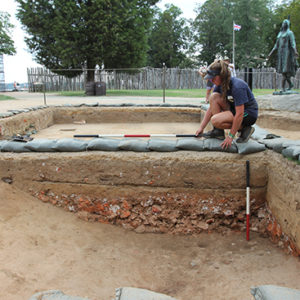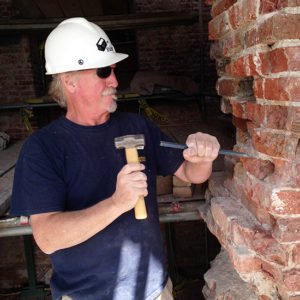The pieces of brick found in large depression just north of the 1907 Memorial Church could be remnants from a brick church that stood more than 300 years ago.
The bowl-shaped depression near the Pocahontas statue was full of broken bricks, some with mortar still on them. None of the bricks in this feature were intact, said Senior Jamestown Rediscovery Archaeologist Danny Schmidt.
“It’s filled with heavy brick and mortar rubble relating to the destruction of a building from somewhere nearby,” he said. “The most likely candidate would be the last brick church that stood here at Jamestown . . . We are finding a lot of very curious bricks in this rubble.”
Master Mason Ray Canetti reviewed the brick bats, some of which have curved tops and others that are five-sided or have beveled edges.
“You can clearly tell they are working the wet clay after the brick has been molded,” he said. He pointed to a brick with five sides and said, “It’s very clear that they are working the green clay to make it. It has a specific place that it’s going. I really love seeing these things because it shows such a sense of purpose. They have a design. They know what they want. They know what they are making.”
These pieces probably come from a building that was a contemporary of Bacon’s Castle in Surry County (1665).
The first church structure at Jamestown was built in 1608 inside the fort and made of wood with walls of a mud covering.
Then, sometime between 1617 and 1619, Governor Samuel Argall ordered construction of a new church “50 foot long and twenty foot broad” a few feet to the east of the 1608 church footprint. This next church was built on a foundation of cobblestones one foot wide capped by a wall one brick thick. These foundations are one of two viewable under the glass portal in the floor of the 1907 Memorial Church. The first legislative assembly was held in the 1617 church.
In January 1639 Governor John Harvey reported that he and other gentlemen “had contributed to the building of a brick church” at Jamestown. This church was slightly larger than the 1617 church and was built around it. It was still unfinished in November 1647 when efforts were made to complete it. Evidence remains inconclusive as to when the brick church tower was added to the west side of the church, though it can be said the tower is the only 17th-century building still standing at Jamestown. It is one of the oldest English-built structures in the United States.
Canetti and Colonial Williamsburg’s masons continue to work this summer on repairing the church tower, which is slightly over 18 feet square with walls three feet thick at the base. Originally the tower was about 46 feet high (10 feet higher than the current tower remnant) and was crowned with a wooden roof and belfry.
Jamestown’s brick church was used until the congregation moved in 1758. While the church structure itself fell into ruin, the churchyard continued to be used for burials through the 18th century. In the late 18th century, Jamestown resident John Ambler used bricks from the deteriorating church to build a wall around some of the gravestones on the church’s east end.
Preservation Virginia (APVA) acquired the church site in the 1890s, and, with funding from the National Society, Colonial Dames of America, built the present Memorial Church in 1906 and 1907 to incorporate the foundations of the two earlier churches. It was designed to mimic St. Luke’s Church and other examples of 17th-century brick churches in England.
And among the brick pieces recently uncovered, Canetti even found a piece that would have easily fit on the gable ends of a 17th-century church, topping the crow steps that go up to the roofline (as can be seen on the 1907 Memorial Church). He said some of the decorative brick fragments were popular in Gothic construction.
Bill Neff of Colonial Williamsburg’s masonry trades department agreed and talked about how similar these brick pieces were to bricks used in Bacon’s Castle. “There was a lot of Dutch influence and Dutch bricks at the time. And Holland bricks are pretty small, like these,” Neff said.
The bowl-shaped depression sits on top of a feature that Schmidt said is likely a cellar and is already yielding many fort-period artifacts. The Jamestown Rediscovery staff has many units open in this area and will continue to explore the cellar feature as the summer turns towards autumn.
related images
- Balk walls and brick fragments in a feature by the Preservation Virginia entrance gate
- Bill Neff of Colonial Williamsburg’s masonry trades department working on Jamestown’s church tower
- Brick with fingerprints








